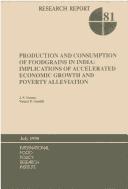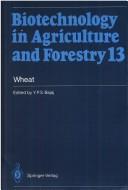| Listing 1 - 6 of 6 |
Sort by
|
Book
ISBN: 9686127402 Year: 1990 Publisher: Mexico CIMMYT
Abstract | Keywords | Export | Availability | Bookmark
Book
ISBN: 0312050380 Year: 1990 Publisher: New York St. Martin's
Abstract | Keywords | Export | Availability | Bookmark
 Loading...
Loading...Choose an application
- Reference Manager
- EndNote
- RefWorks (Direct export to RefWorks)
Wheat trade --- Wheat trade --- Wheat --- Prices --- General Agreement on Tariffs and Trade (Organization)
Book
ISBN: 2870160356 9782870160350 Year: 1990 Publisher: Gembloux : Presses Agronomiques de Gembloux,
Abstract | Keywords | Export | Availability | Bookmark
 Loading...
Loading...Choose an application
- Reference Manager
- EndNote
- RefWorks (Direct export to RefWorks)
Planten --- Plantes --- Blé --- Wheats --- Pratique culturale --- Cultivation --- Variété --- Varieties --- Facteur nuisible --- injurious factors --- Plant and Crop Sciences. Crops --- Cereals --- Wheat --- Wheat. --- Lutte

ISBN: 0896290840 Year: 1990 Publisher: Washington, D.C. International Food Policy Research Institute
Abstract | Keywords | Export | Availability | Bookmark
 Loading...
Loading...Choose an application
- Reference Manager
- EndNote
- RefWorks (Direct export to RefWorks)
Economic growth --- Plant husbandry --- Third World: agricultural and food problems --- India --- Food supply --- -Grain trade --- -Nutrition --- -Poor --- -Wheat trade --- -Wheat industry --- Grain trade --- Disadvantaged, Economically --- Economically disadvantaged --- Impoverished people --- Low-income people --- Pauperism --- Poor --- Poor, The --- Poor people --- Persons --- Social classes --- Poverty --- Alimentation --- Food --- Nutrition --- Health --- Physiology --- Diet --- Dietetics --- Digestion --- Food habits --- Malnutrition --- Produce trade --- Food control --- Agriculture --- Food security --- Single cell proteins --- Economic conditions --- Health aspects --- Wheat trade --- -Food supply --- Wheat industry --- Developing countries: agricultural and food problems
Book
ISBN: 0471928801 Year: 1990 Publisher: Chichester : Wiley,
Abstract | Keywords | Export | Availability | Bookmark
 Loading...
Loading...Choose an application
- Reference Manager
- EndNote
- RefWorks (Direct export to RefWorks)
Blé --- Wheats --- Triticum --- Méthode d'amélioration génétique --- breeding methods --- Ressource génétique --- genetic resources --- Collection botanique --- Plant collections --- Génie génétique --- genetic engineering --- Génétique des populations --- population genetics --- Syrian Arab Republic --- 631.526 --- 633.11 --- Groups and types of cultivated plants. Genetic resources --- Wheats. Triticum --- 633.11 Wheats. Triticum --- 631.526 Groups and types of cultivated plants. Genetic resources --- Wheat --- Breadstuffs --- Cultivated wheats --- Spring wheat --- Triticum aestivum --- Triticum sativum --- Triticum vulgare --- Wheats, Cultivated --- Grasses --- Germplasm resources&delete& --- Congresses --- Germplasm resources --- Alep --- Icarda

ISBN: 3540518096 0387518096 3642080812 3662109336 Year: 1990 Volume: vol 13 Publisher: Berlin, Heidelberg : Springer Berlin Heidelberg : Imprint: Springer,
Abstract | Keywords | Export | Availability | Bookmark
 Loading...
Loading...Choose an application
- Reference Manager
- EndNote
- RefWorks (Direct export to RefWorks)
Wheat, which is the second most important cereal crop in the world, is being grown in a wide range of climates over an area of about 228 945 thou sand ha with a production of about 535 842 MT in the world. Bread wheat (Triticum aestivum L. ) accounts for 80% of the wheat consumption, howe ver, it is attacked by a large number of pests and pathogens; rusts and smuts cause enormous damage to the crop and reduce the yield drastically in some areas. The major breeding objectives for wheat include grain yield, earliness, resistance to lodging and diseases, spikelet fertility, cold tolerance, leaf duration and net assimilation rate, fertilizer utilization, coleoptile length, nutritional value, organoleptic qualities, and the improvement of charac ters such as color and milling yield. The breeding of wheat by traditional methods has been practiced for centuries, however, it has only now come to a stage where these methods are insufficient to make any further breakthrough or to cope with the world's demand. Although numerous varieties are released every year around the world, they do not last long, and long-term objectives cannot be realized unless more genetic variability is generated. Moreover, the intro duction of exotic genetic stocks and their cultivation over large areas results in the depletion and loss of the native germplasm pool.
Triticum --- Blé --- Wheats --- Biotechnologie --- Biotechnology --- Hybridation --- Hybridization --- Culture d'embryon --- Embryo culture --- Culture d'anthère --- Anther culture --- Triticosecale --- Méthode d'amélioration génétique --- breeding methods --- Culture in vitro --- In vitro culture --- Multiplication des plantes --- Plant propagation --- Multiplication végétative --- Vegetative propagation --- Thinopyrum --- Wheat --- Basic Sciences. Biotechnology --- Biotechnology. --- Micropropagation. --- Plant Biotechnology --- Plant Biotechnology. --- Propagation --- In vitro --- Agriculture. --- Forests and forestry. --- Botany. --- Zoology. --- Cytology. --- Forestry. --- Plant Sciences. --- Cell Biology. --- Plant science. --- Cell biology. --- Plant Science.
| Listing 1 - 6 of 6 |
Sort by
|

 Search
Search Feedback
Feedback About UniCat
About UniCat  Help
Help News
News